
Capt. Sutter tells of the Gold Discovery - 1854
Excerpts of John Sutter's Diaries 1838-1848
An Eyewitness to the Gold
Discovery
A Rush to the Gold Washings
— From the California Star
Military Governor Mason's
Report on the Discovery of Gold
William T. Sherman
and the Gold Rush
Dramatic Impact of the
Gold Discovery, by Theo. H. Hittell
The Discovery —
as Viewed in New York and London
Ulysses S. Grant and
the Gold Rush
Gold Rush and Anti-Chinese
Race Hatred
Gold Mining Terms
and Methods
Other Museum Gold
Rush Items
California Gold Rush Chronology
1846 — 1849
California Gold Rush Chronology
1850 — 1851
California Gold Rush Chronology
1852 — 1854
California Gold Rush Chronology
1855 — 1856
California Gold Rush Chronology
1857 — 1861
California Gold Rush Chronology
1862 — 1865
Steamer Day in the 1850s
Sam Brannan Opens New
Bank — 1857
|
Seventy-Five Years of Law in California
How Adventurous Gold Miners Won Immortal Fame as Lawmakers
Told in Graphic Story of Legal Development of West
By JEREMIAH F. SULLIVAN
Dean of San Francisco Bar and
Former President of Bar Association
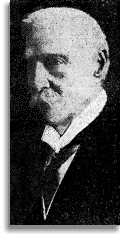 Many
brilliant young lawyers during the early days of California were lured away temporarily
by the hidden gold of mountains and tempted to play with running water and pan and
rocks to obtain the glistening metal that might pave for them a pathway to success
in life. But the jealous mistress, the law, called them back. Many
brilliant young lawyers during the early days of California were lured away temporarily
by the hidden gold of mountains and tempted to play with running water and pan and
rocks to obtain the glistening metal that might pave for them a pathway to success
in life. But the jealous mistress, the law, called them back.
I may be permitted to recall a few names. Foremost among them was California's first
American Civil governor, Peter H. Burnett, a Tennesseean. Years before Marshall's
discovery of gold, Burnett had made the
covered wagon trip to the Oregon country at a time when the region was claimed
by both Great Britain and the United States. In the absence of the local law from
either sovereignty he joined his neighbors in the organization of a provisional
government.
After service as a member of the Supreme Court of Oregon he organized a party to
pioneer into the gold fields of California. He mined at Long's Bar on the Yuba river
before he became the first governor of California in December, 1849.
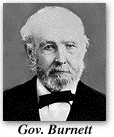 Later he was a Supreme Court Justice of California. It is interesting
to note that the primary purpose of Peter H. Burnett's pioneer pilgrimage to Oregon
and to California was to enable him to pay his business associates in St. Louis,
Mo., an indebtedness he could not otherwise meet. In 1852 he paid them the last
dollar of indebtedness with interest, amounting to $28,740. Toward the end of his
career Burnett was president of the Pacific Bank in San Francisco. Later he was a Supreme Court Justice of California. It is interesting
to note that the primary purpose of Peter H. Burnett's pioneer pilgrimage to Oregon
and to California was to enable him to pay his business associates in St. Louis,
Mo., an indebtedness he could not otherwise meet. In 1852 he paid them the last
dollar of indebtedness with interest, amounting to $28,740. Toward the end of his
career Burnett was president of the Pacific Bank in San Francisco.
Like Thomas McFarland, Judge John Hager mined in Nevada
county before he became a judge of the Fourth District or Collector of Port in San
Francisco.
William P. Daingerfield mined in Shasta county before he became judge of the District
Court, embracing that county, or became judge of the Twelfth District, embracing
San Francisco and San Mateo counties. As presiding judge of the newly created Superior
Court of San Francisco in 1880, in apportioning the business among the twelve departments
of that court, he divided the business of his superseded Twelfth District court
between his own department, One, and Department Two, presided over by Jeremiah F.
Sullivan. Another lawyer-miner of pioneer days was Cornelius Cole, who worked in El Dorado county before he became congressman or United States senator from California.
"The Father of the Codes" of 1872, Creed Haymond, before he attained his majority
or made his study of law, worked in the mines of Sierra county.
Two Pioneer Lawyers, Who Worked for, Though Not With, Miners
Two distinguished men of the law, who counseled the miners and legislated for them,
though not credited with having handled pick, shovel nor pan, are Elisha W. McKinstry
and Stephen J. Field. McKinstry was a member of the Assembly from Sacramento at
the first session of the Legislature which met at San Jose on December 15, 1849,
and ended its work on April 22, 1850. He served the people in various other capacities,
judicial and otherwise, with satisfaction to the public and great credit to himself,
terminating a highly honorable career of over 15 years on the supreme bench by resignation
October 1, 1888.
Shuck, in his history of the Bench and Bar of California says:
"Judge McKinstry wrote the majority opinion (4 to 3) of the State Supreme Court
in that great water rights case of Lux vs. Haggin in May, 1885, and the majority
opinion of that court (also 4 to 3) in the Sharon case, February 1, 1888."
The Lux case was one in which the court held that the Common Law doctrine of riparian
rights prevailed in California. The Sharon decision affirmed a judgment of the Superior
Court sustaining the validity of a Common Law marriage.
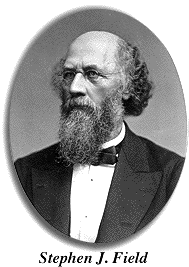 Another
pioneer lawyer, legislator and jurist who did not delve into the sides of the Sierra
was Stephen J. Field. Perhaps more than any other one man he fabricated the law
of California and her sister commonwealths between the Rocky Mountains and the western
sea. He was the Alcalde and justice of the peace in Marysville in 1850, and as a
member of the Assembly in 1851 performed a most valuable service by revising and
formulating the fundamental civil and criminal practice codes of California. An
extra-judicial service greatly to his credit and redounding permanently to the
harmonious working of the California codes enacted in 1872 was that performed in collaboration with
Judge Jackson Temple and John W. Dwinelle under appointment by Governor Booth, as commissioner to
report suggested amendments to the codes at the Legislature of 1873-1874. This work was done thoroughly
with great detail and months of work while Field was a justice of the United States Supreme Court. The
amendments reported by the commissioners and enacted by the Legislature constituted a good-sized
volume of laws, as I well remember, because after opening my law office, June 10, 1874, at 637 Kearny
street I passed several months of my time, not overcrowded with clients, in cutting my bound volume and
inserting each amendment in its appropriate place in my original volume of the codes of 1872. President
Lincoln had appointed Judge Field in 1863 to the supreme bench. His service in the highest court
continued 26 years. A similar long and honorable service by Justice McKenna has given California
representation in the greatest judicial tribunal in the world for more than 50 years. Another
pioneer lawyer, legislator and jurist who did not delve into the sides of the Sierra
was Stephen J. Field. Perhaps more than any other one man he fabricated the law
of California and her sister commonwealths between the Rocky Mountains and the western
sea. He was the Alcalde and justice of the peace in Marysville in 1850, and as a
member of the Assembly in 1851 performed a most valuable service by revising and
formulating the fundamental civil and criminal practice codes of California. An
extra-judicial service greatly to his credit and redounding permanently to the
harmonious working of the California codes enacted in 1872 was that performed in collaboration with
Judge Jackson Temple and John W. Dwinelle under appointment by Governor Booth, as commissioner to
report suggested amendments to the codes at the Legislature of 1873-1874. This work was done thoroughly
with great detail and months of work while Field was a justice of the United States Supreme Court. The
amendments reported by the commissioners and enacted by the Legislature constituted a good-sized
volume of laws, as I well remember, because after opening my law office, June 10, 1874, at 637 Kearny
street I passed several months of my time, not overcrowded with clients, in cutting my bound volume and
inserting each amendment in its appropriate place in my original volume of the codes of 1872. President
Lincoln had appointed Judge Field in 1863 to the supreme bench. His service in the highest court
continued 26 years. A similar long and honorable service by Justice McKenna has given California
representation in the greatest judicial tribunal in the world for more than 50 years. A pioneer
lawyer who preceded the gold seekers was Horace Hawes, who arrived in California in 1847. As Judge
Field was a great factor in the foundation of the permanent law of California. Horace Hawes was possibly
the greatest factor in shaping the political government of San Francisco. Originally the City of San
Francisco was the county seat of the County of San Francisco, one of the first 27 counties organized by
the Legislature February 18 1850. The territory known since 1856 as San Mateo county was the southern
and greater portion of San Francisco county. The first incorporated City of San Francisco was bounded on
the south by a line two miles south of the center of Portsmouth Square parallel with Clay street, and on
the west by a line 1 1/2 miles from the square parallel with Kearny street. The statute of 1856 created
the County of San Mateo and made of the remaining territory of San Francisco county a consolidated City
and County of San Francisco, the smallest bit of territory, but the greatest political and commercial
factor in the upbuilding of the Golden State. Horace Hawes created the original charter of San Francisco.
His Consolidation Act of 1856 has shaped the political history of our local government ever since.
Interregnum Between Mexican Rule and American Law Events affecting the
future of the Mexican province of Alta California followed in quick succession. Active hostilities ceased
when General Winfield Scott,
after battling down the guardian fortresses of Molinao del Rey and Chapultepec, at the gates of the
Mexican capital, stood in the center of the Grand Plaza, September 14, 1847, and bared head and uplifted
sword proclaimed the conquest of Mexico. The treaty of Guadalupe
Hidalgo, defining the terms of peace, was signed on February 2, 1848, and finally proclaimed by President
Polk July 4, 1848. 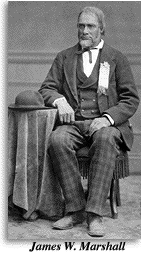 Immediately following
the cessation of hostilities with Mexico, and the proclamation of peace, an event of epochal importance transpired
on the south fork of the American river on the lands of John A. Sutter, a Swiss, who had become a Mexican citizen.
Convinced that the public attention which the war had focused on California would result in a large influx of
newcomers and a resulting demand for lumber, Sutter sought the co-operation of a New Jersey millwright named
[John] Marshall to build in partnership with him a sawmill at a point known as Coloma in El Dorado county. As the
mill was nearing completion a change in the tail-race became necessary, which involved digging up of the river
bed at the lower end and the release of accumulated waters over the rocks and earth at the bottom. The sluicing over
night left exposed to the astonished eyes of millwright Marshall in the morning a glittering substance
which proved to be gold. The exact date of the discovery is in dispute. Hittell in
his history of California gives January 19, 1848, as the date. No dispute has ever existed as to its effect. Within
five years twelve hundred million dollars in gold were extracted from its repository of the ages in California and
placed in the coffers of the world. Alta California has become a foremost American commonwealth and the vast
stretch of territory from Baja (Lower) California to British Columbia and from the Rocky Mountains to the great
western ocean has become an unbroken field of American states. Immediately following
the cessation of hostilities with Mexico, and the proclamation of peace, an event of epochal importance transpired
on the south fork of the American river on the lands of John A. Sutter, a Swiss, who had become a Mexican citizen.
Convinced that the public attention which the war had focused on California would result in a large influx of
newcomers and a resulting demand for lumber, Sutter sought the co-operation of a New Jersey millwright named
[John] Marshall to build in partnership with him a sawmill at a point known as Coloma in El Dorado county. As the
mill was nearing completion a change in the tail-race became necessary, which involved digging up of the river
bed at the lower end and the release of accumulated waters over the rocks and earth at the bottom. The sluicing over
night left exposed to the astonished eyes of millwright Marshall in the morning a glittering substance
which proved to be gold. The exact date of the discovery is in dispute. Hittell in
his history of California gives January 19, 1848, as the date. No dispute has ever existed as to its effect. Within
five years twelve hundred million dollars in gold were extracted from its repository of the ages in California and
placed in the coffers of the world. Alta California has become a foremost American commonwealth and the vast
stretch of territory from Baja (Lower) California to British Columbia and from the Rocky Mountains to the great
western ocean has become an unbroken field of American states.
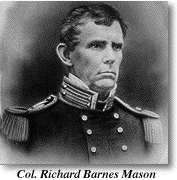 On February 12, 1848, Colonel Richard B. Mason, as Acting
Governor of California, made a proclamation abrogating Mexican mining laws and customs in California. Whether Mason's
proclamation amounted to a mere brutum fulmen, or not, it served a useful purpose, preventing the assertion of
false claims of mine ownership or operation based on the former Mexican law. On February 12, 1848, Colonel Richard B. Mason, as Acting
Governor of California, made a proclamation abrogating Mexican mining laws and customs in California. Whether Mason's
proclamation amounted to a mere brutum fulmen, or not, it served a useful purpose, preventing the assertion of
false claims of mine ownership or operation based on the former Mexican law. The Argonauts Were First American
Lawmakers Certainly no Mexican law governed ownership or operation of mines on public lands already the
property of the United States. No law of the United States regulated the sale of mining lands or their operation by an
invading army of gold seekers. Immediate or early Congressional legislation seemed improbable. Of the thirty organized
governments constituting the United States 15 favored the maintenance and expansion of the institution of slavery. An equal
number stood in opposition. Legal chaos confronted the adventurous, earnest, honest men who faced failure or success at the
end of their pilgrimage. With the Anglo-Saxon respect for law and order and for personal rights and property, and with purely
American initiative, these miners in a moment evolved from their own brains and through their united harmonious action a
system of rules and usages concerning the occupation and operation of mines which at once became law. Speaking of this
miner-made law and its equal operation, Judge Field, in behalf of the United States Supreme Court, said: "Nothing
but such equality would have been tolerated by the miners, who were emphatically the lawmakers as respects mining upon the
public lands in the state. The rules and regulations originally established in California have in their general features
been adopted throughout all of the mining regions of the United States. They were so wisely framed and were so just and fair
in their operation that they have not to any great extent been interfered with by legislation state or national. In the first
mining statute, passed July 9, 1866, they received the recognition and sanction of Congress, as they had previously the
legislative and judicial approval of the states and territories in which mines of gold and silver were found." These
discriminating mining legislators initiated a different rule for load claims from that applied to placers. Departing from
the Common Law they ordained that the ownership should attach to the thin sheet-like quartz veins and that a claim
should consist of a certain horizontal block of the vein, however it might run, but extending indefinitely downward with
a strip of surface on or embracing the vein's outcrop for the necessary machinery and buildings. Ownership and working
of quartz vein did not preclude different ownership and use of the surface above for commercial or agricultural purposes.
Thriving towns have been built and owned in small holdings, while hundreds, and in some cases thousands of feet underneath
mining operatives extracted the precious metals from the veins. Similarly these wise pioneers of the West devised and
operated plan for the use in mining of necessity water on public lands. The great seal of the State of California carries
as its foreground a figure of the Goddess Minerva, fabled as having sprung full grown from the brain of Jupiter, designed to
symbolize the full-grown political birth of the state. It may be well claimed to symbolize also the instantaneous
full-grown birth in California of the mining and water law of western America. The Constitution of 1849
On June 3, 1849, Bennett Riley announced by direction of his superior officers that he has assumed the administration of
civil affairs in California, not as a military governor, but as the executive of an existing civil government whose character
and organization he defined. At the same time he called for a convention to meet at Monterey to frame a constitution. Such a
convention met in Colton Hall, Monterey, on September 1, 1849, and worked continuously, intelligently and conscientiously
until it completed its labors on October 13. Robert Semple of Benicia was president,
William G. Marcy, secretary, and J. Ross Brown, official reporter of the convention. Besides the president, 47 other
members signed the constitution. The personnel embraced 36 natives of Eastern States, New York having 11. Seven native
Californians were members; also one native from each of the following countries: France, Ireland, Scotland, Spain and
Switzerland (John A. Sutter). Fourteen styled themselves lawyers and one gave his profession as "U.S. Engineer," being
the same H.W. Halleck, who as secretary of state had attested Governor Riley's call for the convention. A graduate of West
Point, a distinguished engineer and for a time was one of San Francisco's law firm of Halleck, Peachey, Billings & Park,
which, between July and December of 1853, as owners, built the Montgomery block at Washington, Montgomery and Merchant
streets. For years it was the nest of the greatest collection of law books and lawyers in California. Halleck must have
been a good engineer as Montgomery block is still where he put it. His public papers, his convention debates and his
published works prove him a good lawyer. The constitution was framed in line with the best organic law of American
commonwealths. It ruled the state without fundamental change for 30 years. Space permits reference to only a few points.
William E. Shannon, 27 years old, a native of Ireland and three years a resident of California, secured the declaration
in the Bill of Rights that neither slavery or involuntary servitude, unless for the punishment of crimes, shall ever be
tolerated in this state. While securing the freedom of other races, the legislators believed in the emancipation of
the married woman of their own. Favoring the common as contradistinguished from the civil law, they abolished the common
law penalties of loss of identity and loss of property inflicted on the women of property who married. The debates show
that the provision was incorporated into the constitution instead of being left to the Legislature in order to insure its
perpetuity. Among its motives were its inherent justice to the woman herself; the immunity of the woman's property against
spoliation or loss in the reckless whirl of mining adventures of the time, and finally, a chivalrous impelling urge was
found in the fact that a small percentage of the citizenry represented by a small membership in the convention had grown
up under the system of Spain and Mexico and become accustomed to the better treatment of women. This honest and chivalrous
treatment of women has been characteristic of Californians throughout 75 years of the law, constitutional and statutory.
Early Legislation
The people of California on November 13, 1849, adopted the constitution and
elected the officers of the state, therein provided for. The Legislature thus elected met at San Jose on December 15
following. The statutory work to carry out the directions and to supplement the legislation of the constitution itself
was well and quickly done.
The state was organized into counties (originally 27) and into judicial districts (originally 9).
The Common Law of England as Americanized, was adopted by the statute April 13, 1850. In addition a general scheme of
legislation for the proper functioning of the state and its officers was made effective.
The Legislature at its next
session in 1851 rounded out the hastily prepared governmental scheme of 1850, and under the dominating influence of
Assemblyman Stephen J. Field gave permanent form to the statute of crimes and punishments and to the general laws affecting
personal and family relations and to the civil, probate and criminal practice in our courts.
The First California
Codes In 1872, after strenuous and very competent labor by Creed Haymond and his associates, and a very
elaborate report by the commission, the general laws of the state were segregated into four codes--Civil, Civil Procedure,
Penal and Political. Each code was enacted as a single statute. The Legislature of 1871-1872 directed that the code provisions
should become effective as of the first day of the following year. Amendments of the law since that date are made by reference
to the appropriate sections of the code affected. With but unimportant amendment the constitution of 1849 ruled the state
for 30 years. As authorized by Section 2 of Article X of the constitution, the Legislature of 1876 submitted to the people
a proposition to call a convention. The people voted in favor of the proposition. The people voted in favor of the proposition.
On March 30, 1878, the Legislature passed an act calling for the election on June 19, 1878, of 152 delegates to the convention.
The delegates elected met in Sacramento, September 28, 1878. On March 3, 1879, the convention adopted the constitution.
On May 7, 1879, a new constitution was adopted by a vote of the people. It took effect
July 4, 1879, as to the election of officers, the commencement of terms and the meeting of the Legislature. In all other
respects it took effect January 1, 1880. To a lawyer the outstanding change wrought by the constitution of 1879 was the
creation of an entirely new judicial system. All former courts, save justices and police courts, were abolished. The County
Courts and the 23 District Courts and the former Supreme Court of five justices ceased to exist January 1, 1880.
The new court of Chief Justice and six associate justices, which took office Monday, January 5, 1880, consisted of Robert
F. Morrison, chief justice, and Samuel Bell McKee, Erskine M. Ross, John R. Sharpstein, James D. Thornton, E.W. McKinstry and
M.H. Myrick, associate justices... .
The new system created a Superior Court for each county in lieu of the former county
courts and of the 23 district courts. The court in San Francisco was to have 12 judges, but one judge was to be elected by
the two courts of Yuba and Sutter counties, the unique distinction of filling two offices going to Judge Phil W. Keyser of
Marysville, who was district judge in the Tenth District covering the counties named.
Six counties were allowed two
judges each for their courts, viz., Alameda, Los Angeles, Sacramento, San Joaquin, Santa Clara and Sonoma. San Francisco
was given 12 judges... .
The courtrooms of the first eight [San Francisco judges] were in what was known in those days as the old City Hall on
Kearny street, the site of the present Hall of Justice. The chambers in which they discharged officials duties when not
on the bench were in Montgomery block. Judges Finn and Halsey had courtrooms and chambers in the then unfinished new
City Hall, corner of McAllister and Larkin streets, the site of the former Yerba Buena (City)
Cemetery. Judges Freelon and Ferral transacted the criminal business, and their departments in quarters located on
the west side of Montgomery street north of Washington. The business has increased in 45 years. Sixty-nine Superior
Court judges were provided in 1880. One hundred and thirty-two are supplied now. The Supreme Court of 1880 is no
longer adequate to the appellate work. By constitutional amendment District Courts of Appeal were established as an
intermediate system, one such court sitting in Sacramento, for the northern counties; one at San Francisco for the central
counties, and the third in Los Angeles for the southern district, each court having three judges. A continued increase of
business demanded the additional divisions of the District Court of Appeal are housed in the State Building at the Civic
Center. The departments of the Superior Court, with the exceptions of those handling criminal cases in the Hall of Justice,
have quarters in the City Hall at the Civic Center, as fine a courthouse as can be found in the United States.
California Jurisprudence Leads
The pioneers who astonished the world by the instant creation of
codes of mining and water laws for the western mining world are no longer with us. But the mold in which they were cast
was not broken. As a Californian it has been my boast that the pioneers who builded our American state reared such a race
of fair, virtuous women, of honest, brave and brainy men as forms a fitting complement for the wealth and beauty with which
God and Nature have endowed our loved Californian land. The California law of the closing 75-year period is the most romantic
as well as the most useful offering to the world's progress. I trust that in the future, as in the earlier days, California
lawyers may prove themselves doers of high-class public service and counselors of the commonweal. Their highest
obligation is to perpetuate the respect for the Constitution of the United States shown by founders of the commonwealth.
The Bulletin
Diamond Jubilee Edition
September 8, 1925
Return to the top of the page.
This site and contents ©1995-2013 The Museum of the City
of San Francisco
|